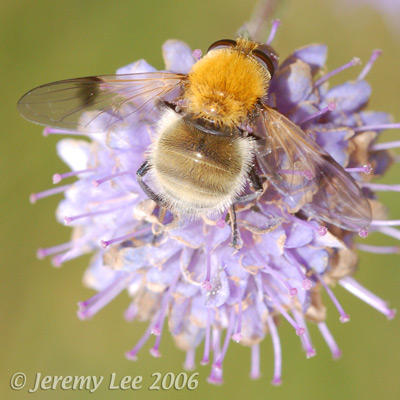
 |
|
Scientific Classifications explained » Amphibians » Ants » Aphids » Bees » Beetles » Birds » Bugs » Butterflies » Caterpillars » Damselflies » Dragonflies » Earwigs » Flies » Frog/Leafhoppers » Fungi » Galls » Grasshoppers » Harvestmen » Hoverflies » Lacewings » Ladybirds » Leaf Mines » Lichens » Mammals » Millipedes » Mosses » Moths » Sawflies » Slugs » Snails » Spiders » Trees & Shrubs » Wasps » Wild Flowers » Woodlice » Postboxes |
UK Nature > Hoverflies > Arctophila superbiens

Scientific Name: Arctophila superbiens Common Name: N/A Arctophila superbiens gives the appearance of an entirely orange-haired bumblebee but with a dark patch on the wing below the stigma. Sometimes the hairs are grey rather than orange-brown. The thorax always has a yellowish ground colour, but the abdomen may either have a similar background colour or be vaguely blackish. It is largely a northern and western species in the UK that is relatively frequent in west Wales and parts of south-west and north-west England. It is also widespread in Scotland, though rather localised. It is largely absent from south-east England, but old records are known from woodland in the Cotswolds and Berkshire. Adults favour the margins and clearings of wet acidic woodlands and are particularly attracted by the flowers of the Devil's-bit Scabious (Succisa pratensis) at the end of the summer (as in the photograph above). Active May to November, peaking in September. |
|

https://www.uknature.co.uk is a website dedicated to showing the immense diversity of UK nature and wildlife. Our vast range of habitats, from lowland arable to snow covered mountains, from storm-ravaged coastlines to peaceful inland freshwater lakes and rivers, from dry, sandy heaths to deciduous and coniferous forests, all these habitats contribute to the abundance of UK nature. We have wild birds in huge numbers either residing or visiting our shores (597 recorded species as at July 2013) and we must also not forget the humble back garden with its grass lawns, flower beds filled with nectar rich flowers, shrubs and trees, all designed to attract huge numbers of insects such as bees, moths, butterflies and hoverflies; and finally the small ponds which provide safe havens for frogs, toads, newts and even slow worms and grass snakes. www.uknature.co.uk is the showcase for my personal passion, photographing uknature in all its glory. I sincerely hope you all enjoy the fruits of my labours. This site and all images contained therein is © Jeremy Lee 2004 - 2025. All Rights Reserved. Site design by Jeremy Lee. Site development & IT Support by Stuart Lee. |